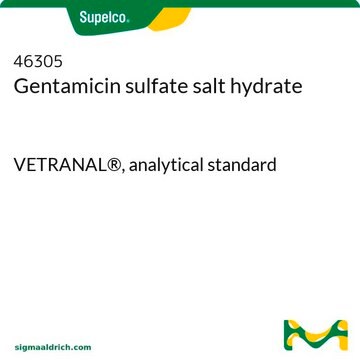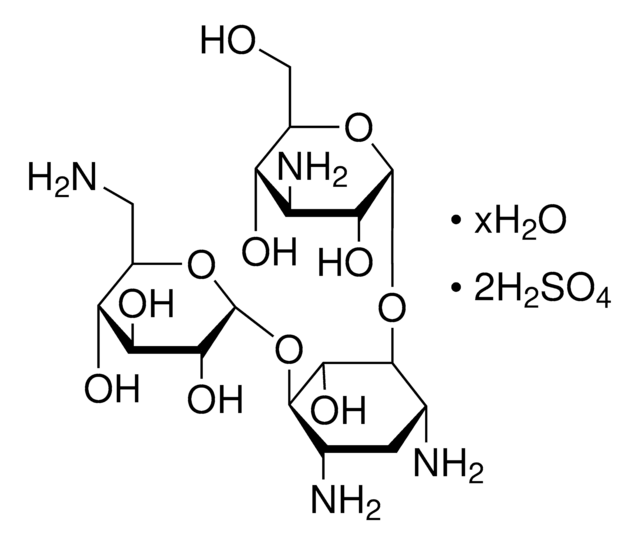A2024
Apramycin sulfate salt
Sinonimo/i:
Nebramycin II
About This Item
Prodotti consigliati
Origine biologica
Streptomyces tenebrarius
Livello qualitativo
Forma fisica
powder
Colore
white to brown
Spettro attività antibiotica
Gram-negative bacteria
Modalità d’azione
protein synthesis | interferes
Temperatura di conservazione
2-8°C
Stringa SMILE
OS(O)(=O)=O.CN[C@H]1[C@@H](O)[C@H]2O[C@H](O[C@@H]3[C@@H](N)C[C@@H](N)[C@H](O)[C@H]3O)[C@H](N)C[C@@H]2O[C@@H]1O[C@H]4O[C@H](CO)[C@@H](N)[C@H](O)[C@H]4O
InChI
1S/C21H41N5O11.H2O4S/c1-26-11-14(30)18-8(33-20(11)37-21-16(32)13(29)10(25)9(4-27)34-21)3-7(24)19(36-18)35-17-6(23)2-5(22)12(28)15(17)31;1-5(2,3)4/h5-21,26-32H,2-4,22-25H2,1H3;(H2,1,2,3,4)/t5-,6+,7-,8+,9-,10-,11+,12+,13+,14-,15-,16-,17-,18+,19+,20-,21-;/m1./s1
WGLYHYWDYPSNPF-RQFIXDHTSA-N
Cerchi prodotti simili? Visita Guida al confronto tra prodotti
Categorie correlate
Descrizione generale
Applicazioni
Azioni biochim/fisiol
Confezionamento
Altre note
Avvertenze
Danger
Indicazioni di pericolo
Consigli di prudenza
Classi di pericolo
Repr. 1B
Codice della classe di stoccaggio
6.1C - Combustible acute toxic Cat.3 / toxic compounds or compounds which causing chronic effects
Classe di pericolosità dell'acqua (WGK)
WGK 3
Punto d’infiammabilità (°F)
Not applicable
Punto d’infiammabilità (°C)
Not applicable
Dispositivi di protezione individuale
Eyeshields, Faceshields, Gloves, type P2 (EN 143) respirator cartridges, type P3 (EN 143) respirator cartridges
Certificati d'analisi (COA)
Cerca il Certificati d'analisi (COA) digitando il numero di lotto/batch corrispondente. I numeri di lotto o di batch sono stampati sull'etichetta dei prodotti dopo la parola ‘Lotto’ o ‘Batch’.
Possiedi già questo prodotto?
I documenti relativi ai prodotti acquistati recentemente sono disponibili nell’Archivio dei documenti.
I clienti hanno visto anche
Il team dei nostri ricercatori vanta grande esperienza in tutte le aree della ricerca quali Life Science, scienza dei materiali, sintesi chimica, cromatografia, discipline analitiche, ecc..
Contatta l'Assistenza Tecnica.













